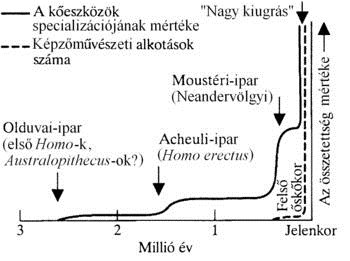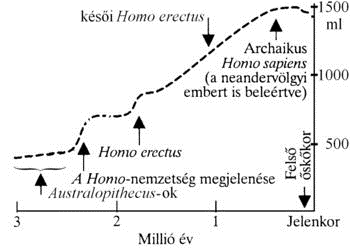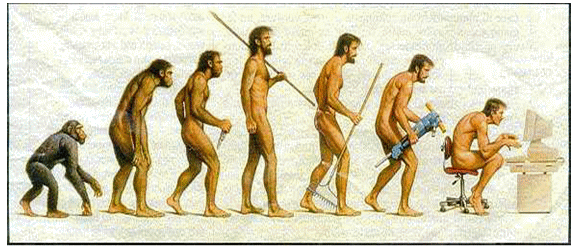I.2.2. The codes of the past. – our inheritance
In their lives modern people carry the genetic codes of their ancestors’ hard work and increasingly rationalistic physical activity, as well as the characteristics of their thinking. Eigen and his colleagues (1971) came to the conclusion that genetic codes had been the first in human cells and they had existed as early as 4 billion years ago. It means that less than 1 billion years were needed for the first cell to come into being and later the multi-cell beings came into shape in 3 billion years. This fact proves that the human body works like a precision mechanism, and its health is the result of 3-billion year-development of very complex processes.
The most dynamic change, the period of evolution took place about 2.5 – 3 million years ago and this period is known as the ’big leap’.
The time of the ’Big Leap’.
The phrase the ’ Big Leap’ (Wikipédia) was invented by Jared Diamond, American scholar and by this term he meant the relatively short period of time, during which the anatomically modern man (Homo sapiens) acquired those skills and capabilities, which are typical of him today. (Figures 1/a –1/b.) The achievements, approved by anthropologists, including the use of tools, art works, articulated speech, demonstrate the harmony between body and mind capacity. It was this change that the ape, then the human being was able to use his own capabilites, then the natural resources to the maximum. Today we rather think that it was not the use, but exploitation of resources was the most important issue in this porcess. .

Figure 1/a. Types and number of stone tools and art works by Richard Leakey. By some anthropologists the varied material from the upper paleolithic era refer to the short period of speech evolution.

Figure 1/b. The changing brain capacity of human ancestors by Richard Leakey during the 3 billion years of evolution. The diagram suggests that human speech developed gradually.
The preservation of health is dependent on qualitative and quantitive indicators as well as well-balanced nutrition. Our genetic codes – due to the evolution – would prescribe the operational rules for our bodies.
Our human ancestors laid the foundation for:
- The quality and quantity of movement necessary for homeostasis. (Wikipedia)
- Thinking and deliberate actions which are necessary for humans.
- Tendencies for development and disintegration from birth to old age.
- The operation of the body.
- The quantity of movement and the related periods of rest
- The harmony between movement and nutrition
The above described rules practically mean that it is not possible to eat more or less without harming our bodies than what had been prescribed by our genetic code. The same rule applies to physical activities. It is also necessary to pay attention to the proportion and harmony between physical activities – nutrition –rest.
During the past two centuries work forms have undergone a major transformation, but this change has been most typical in the last few decades. In general it can be said that physical activities have become less important. Hard physical work has been replaced by machinery, a fact, which might even be beneficial for people. But, according to our codes, the human body needs some physical activity. (Graph 1) Unfortunately this need has not yet become manifest neither in personal nor in social life. Due to this feature the development and intelligence of movements, the preservation of health are of low prestige these days. These areas of culture have to be built up on heredity, learning and imitation.
It has become common to talk about the significance of memes. – The word meme was first mentioned by Richard Dawkins in 1976 in his book, entitled The selfish gene. The author derived the word from the word ’mimema’, meaning ’imitation’. In the opinion of Dawkins, meme means the unity of cultural transfer and imitation. Dawkins rose the idea that the theory of evolution (Wikipédia) can be related to elements of culture as well. This is how, using the analogy of the word ’gene’, he created the word ’meme’ and when using it, he denoted the copiable elements of culture. By the definition of the Oxford English Dictionary the meme is „an element of culture, which is passed from one individual to another by means of imitation. Susan Blackmore, a frequently quoted expert of memetics also agreed with the above definition in one of her articles, published in 1998. (Wikipédia, 2014.04.10. 10.17’)
Unfortunately, it is also true, that memes are as selfish as genes. This fact explains the unhealthy eating habits of Hungarians and their reluctance to do physical activities. The basic problem is that the necessity to do some physical activity related to a job or transport ceased to exist. Prehistoric man used approximately 4000 Kcal every day because he had to hunt, run, and was exposed to harsh climatic conditions. On the other hand contemporary men burn only 400 kcal/day. .

Picture 1.The sitting man
Source: Kovács Tamás Attila: A rekreáció főbb irányzatai Magyar
Sporttudományi Szemle 2007/2